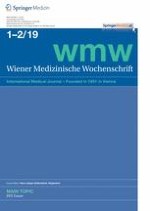22.10.2018 | themenschwerpunkt
Die Rolle der molekularen Bildgebung (PET-CT) in der Diagnostik und Therapie des Prostatakarzinoms
Erschienen in: Wiener Medizinische Wochenschrift | Ausgabe 1-2/2019
Einloggen, um Zugang zu erhaltenZusammenfassung
In den Industrieländern stellt das Prostatakarzinom die häufigste Tumorart des Mannes dar. Beim biochemischen Rezidiv nach Prostatakarzinom stellt die molekulare Bildgebung mittels PET-CT bzw. PET-MRT ein vielversprechendes Verfahren bei der Suche nach einem Lokalrezidiv, Lymphknotenbefall bzw. Fernmetastasen dar. Von den bisher eingesetzten Radiopharmaka haben sich die radioaktiv markierten PSMA-Liganden (z. B. Ga-68 PSMA) durchgesetzt. Es gibt auch mittlerweile gute Therapieansätze mit PSMA Liganden (z. B. Lu-177 PSMA) bei metastasierter Erkrankung.
Anzeige
